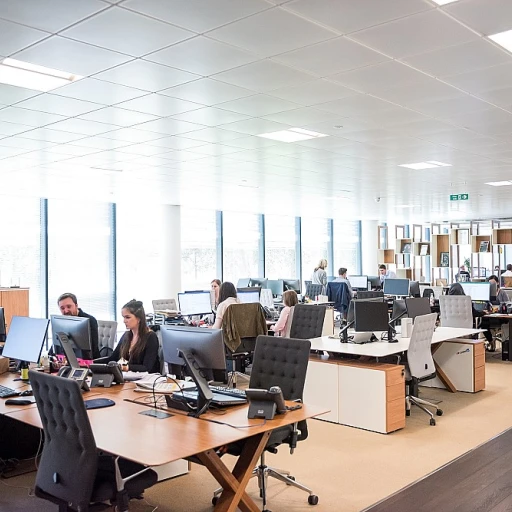The Rise of Hybrid Work Models
Embracing Flexible Work Arrangements
As organizations navigate the evolving landscape of work, one of the most significant shifts we've observed is the rise of hybrid work models. This approach blends remote work with traditional in-office settings, offering employees the flexibility and autonomy they've increasingly come to value. The pandemic has accelerated the adoption of these flexible arrangements, and they appear to be here to stay.
The hybrid model empowers individuals to tailor their work environments to better suit their daily lives and personal preferences. This flexibility not only helps employees achieve a healthier work-life balance but also enhances productivity and satisfaction. Companies that embrace this trend are likely to see happier, more engaged teams, and ultimately, better business outcomes. For insights on enhancing employee engagement in this evolving context, you might find this article on
future of employee engagement useful.
Adopting this model requires thoughtful planning and execution, especially when considering the cultural and technological adaptations necessary to make it work effectively. As we look forward, it's crucial to recognize that prioritizing mental health and fostering an inclusive work culture, topics we'll explore further in this article, are key components of a successful hybrid strategy.
Prioritizing Mental Health in the Workplace
Elevating Mental Health as a Workplace Priority
The growing recognition of mental health's impact on the corporate environment has prompted organizations to integrate mental well-being initiatives into their employee experience strategies. This push towards inclusive mental health practices extends far beyond occasional wellness seminars or employee assistance programs. Organizations are now weaving mental health into the fabric of their corporate culture.
Companies are adopting innovative approaches to tackle mental health challenges. Initiatives such as providing access to virtual therapy services, dedicated mental health days, and mindfulness training sessions are becoming prevalent. These programs are designed to empower employees with tools and resources, fostering a supportive environment that prioritizes well-being.
The role of leadership in promoting mental health is crucial. Leaders who openly discuss mental health and model healthy behaviors cultivate a culture of transparency and trust. This cultural shift encourages employees to seek help without fear of stigma, ultimately improving overall organizational health and productivity.
Moreover, incorporating feedback mechanisms gives employees a platform to voice their needs and concerns regarding mental health support. By acting on this feedback, companies can continuously adapt their strategies to better suit the evolving needs of their workforce.
Enhancing Employee Engagement Through Feedback
Utilizing Employee Feedback for Enhanced Workplace Engagement
In today's ever-evolving work landscape, fostering a robust sense of belonging and motivation among employees is more crucial than ever. As organizations continue to explore hybrid work models and stress the importance of mental health in the workplace, feedback becomes an essential tool in enhancing employee engagement.
Employee feedback serves as a valuable bridge between employers and employees, allowing for open communication and continuous improvement. By actively listening to employee insights and concerns, leaders can make informed decisions that align with both organizational goals and workforce needs. Moreover, feedback mechanisms can provide critical data for assessing the success of an organization’s work policies, such as those related to remote and hybrid work arrangements.
One effective approach is to implement regular feedback loops, where employees are encouraged to share their thoughts on various aspects of their job, including management practices, work-life balance, and the use of technology in their daily tasks. This culture of openness not only empowers employees but also signals a genuine commitment from employers to create a more inclusive and supportive work environment.
By integrating feedback into the core business strategy, organizations can also improve employee morale and retention. A workforce that feels heard and appreciated is more likely to stay committed and thrive within the company. Furthermore, as explored in the discussion on prioritizing mental health, feedback can reveal areas where companies can enhance their efforts to support employee well-being and overall satisfaction.
Incorporating regular, honest communication can lead to a more engaged and motivated workforce, ultimately driving organizational success. For more insights on how organizations are embracing employee well-being for future success, explore our in-depth analysis
here.
The Role of Technology in Employee Experience
Embracing Technology to Transform the Employee Experience
In today's rapidly evolving workplace, technology is playing a pivotal role in reshaping how employees experience their work environment. From streamlining communication to enabling flexible work models, technology is a key enabler in the modern workplace.
One major technological advancement revolutionizing the employee experience is the use of collaborative platforms. These platforms facilitate seamless communication and cooperation among team members, regardless of their physical location. This capability is essential in supporting the hybrid work models many organizations are adopting, as discussed earlier in our article.
Furthermore, technology is instrumental in providing real-time feedback mechanisms, which can significantly enhance employee engagement. Interactive dashboards and performance tracking tools allow employees to receive instant feedback, helping them to adjust their work practices and improve productivity in an engaging manner.
Another notable trend is the integration of AI-driven tools and data analytics in human resource processes. These technologies are helping organizations to better understand their workforce and tailor experiences to individual employee needs. From personalized learning modules to career development pathways, AI is enabling a more customized approach to employee satisfaction and growth.
However, it's important to remember that while technology provides numerous benefits, it must be implemented thoughtfully to ensure a positive impact on the workplace culture. Organizations should aim for a balance between technological advancements and human interaction, fostering an environment where employees feel supported and valued.
As technology continues to evolve, businesses must stay agile and forward-thinking, ready to adopt innovations that can enhance the employee experience. This focus will not only improve employee satisfaction but also contribute to organizational success in the long run.
Building a Positive Organizational Culture
Fostering a Cooperative Environment
Creating a positive organizational culture is more crucial than ever in today's rapidly evolving workplace. The shift towards hybrid work models, as highlighted earlier, necessitates a culture that supports both in-office and remote employees, making everyone feel included and valued. Building such an environment involves a blend of open communication, recognition, and shared values.
One vital aspect of cultivating a high-performing organizational culture is promoting transparency and trust. Encouraging leaders to communicate effectively and regularly with their teams can help bridge any gaps that may arise, especially when working in a hybrid setup. This fosters a sense of security and well-being among employees, helping them to stay engaged and motivated.
Recognition and appreciation also play significant roles in maintaining a positive culture. When employees feel valued for their contributions and efforts, it creates a ripple effect, enhancing overall morale and productivity. Leaders can ensure that appreciation is not just a top-down approach but is embraced across all levels of the organization.
Shared values and common goals unify a workforce, directing efforts towards a common purpose. Organizations that clearly define and communicate their core values can cultivate an emotionally invested workforce, driving engagement and retention.
Ultimately, building a positive workplace culture goes hand-in-hand with prioritizing mental health and leveraging the power of feedback. A supportive culture not only addresses employees' current needs but also positions the organization for future successes by fostering resilience and adaptability in its people.
Future Trends in Employee Experience
The Intersection of Innovation and Employee Experience
The horizon of employee experience is expanding beyond the traditional paradigms, moving towards a more innovative and inclusive approach that reflects the changing dynamics of the workplace. As organizations navigate these evolving landscapes, several key trends are emerging that will shape the future of employee experience.
Firstly, the integration of technology is set to play an even more significant role. Artificial intelligence (AI) and machine learning are not only streamlining operations but also personalizing employee interactions, thus enhancing engagement and productivity. Organizations that leverage these technologies to create more intuitive and responsive work environments will likely see a marked improvement in employee satisfaction and performance.
Moreover, the emphasis on mental health and well-being, highlighted previously, will continue to grow. Companies are recognizing the value of supporting employees' mental health, thereby encouraging resilience and a more balanced work-life integration. Future trends suggest employers will deepen their investment in mental health programs, creating holistic support systems that cater to diverse needs.
Another trend is the shift towards more diverse and equitable workplace cultures. As the importance of building a positive organizational culture is maintained, companies are committing to diversity, equity, and inclusion (DEI) initiatives. This trend reflects a broader societal movement towards fairness and representation, and it is poised to transform workplaces into more welcoming and empowering environments.
Finally, the role of leadership is evolving. Future-forward leaders are expected to foster environments that prioritize feedback, adaptability, and continuous learning. This transformation in leadership styles aligns with the need to enhance employee engagement through feedback mechanisms, ensuring teams feel heard and valued.
In conclusion, as companies embrace these trends, they pave the way for a redefined employee experience—one that is adaptive, inclusive, and deeply attuned to the needs of the modern workforce.







